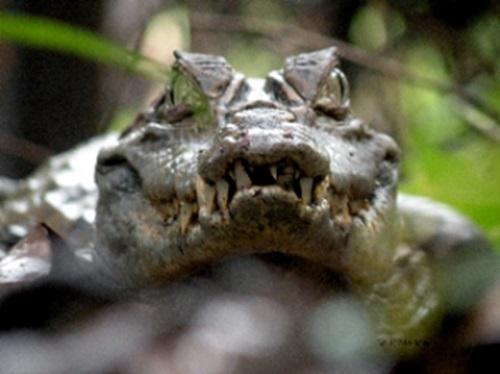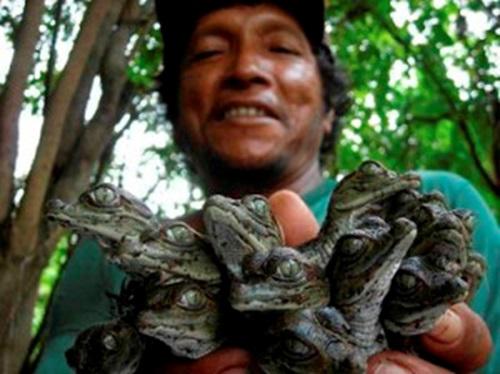Boris Marioni
The aim of this study is to implement a community-based monitoring program of caiman’s populations, for future sustainable commercial harvesting in Brazilian Amazon. The project promotes legal markets and creates the bases for wildlife management programs allying scientific and local knowledge.

Caiman female guarding the nest.
Five species of caiman are found in the Brazilian Amazon floodplains. Black caiman (Melanosuchus niger) and Spectacled caiman (Caiman crocodilus) have suffered in the past high hunting pressure, which is still underway in spite of legal traffic being prohibited since 1967. We estimate that around 100 tons of these species are illegally trade yearly in Sustainable Development Reserve Piagaçu-Purus area and this activity is an important money-source for local people. Because of the continuous threats; Caiman Conservation Program of Instituto Piagaçu has monitored distribution, abundance, reproduction areas and hunting status of caiman populations since 2005 in the region. In 2007 it was the beginning of the community-based Caiman Nests Monitoring Program, which permit gathering valuable scientific data on reproductive ecology of caimans in different localities of SDR Piagaçu-Purus.

Hatchlings of Caiman crocodilus.
During implementation of the management plan, local residents will play a crucial role participating actively to the entire process (monitoring, enforcement, commercialization, decision-making). With this new proposal we expect to train a major number of local inhabitants to collect precious information on wild caiman population that will permit in the future to estimate sustainable harvesting quotas. Caiman monitoring program will produce information on population abundance and density, distribution of nesting areas, habits of reproductive females and it will estimate the efficacy of protection and managed harvesting measures on caiman populations.
The Amazonas State environmental authorities are also promoting caiman management programs inside local Reserves. Wildlife harvesting programs combine conservation efforts to the sustainable use of the species and creating, at the same time new economics alternatives to local inhabitants. Management plans aiming conservation and local financial development must have solid scientific bases and should include both biological data on caiman populations and the social and economic reality experienced by the local people living inside and around the Reserve. Additional data on the demand of caiman meat, skin and other caiman products in the regional market will also be collected to develop the activity for local income generation.
The Caiman Conservation Program will also hold regular meetings jointing local hunters, buyers, local authorities, researchers, technicians and inhabitants of other protected areas dealing with similar issues for sharing experiences. Educational activities aiming to inform and discuss future perspectives on Amazonian caimans in local schools and community centre will also be carried out.